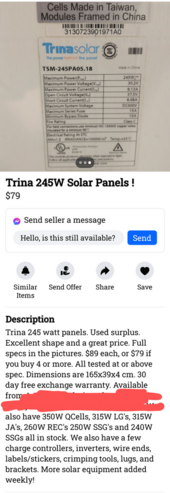michileigh87
New Member
I'm trying to design a solar system, but I'm just getting more and more confused. I feel like I just need to see examples of complete systems or to have someone just tell me what to buy
I live in a small off-grid home that currently has 2 mismatched solar panels, a 1500w/3000w Flamezum inverter, a Pow-keeper 1240 charge controller, 3 Mighty max ML 100-12 batteries.
I live in a super sunny area with no restrictions on solar.
I am open to starting from scratch with the system and my budget is 4k.
I won't need much.
Always on items:
Internet 40w
Fridge/freezer (open to suggestions)
Water pump max draw 17A- intermittent use
Heat lamps/thermostats for 3 reptiles
Sometimes on items:
27" LCD tv
Laptop
Record player
Circular saw
Small vacuum
2 fans
2 lamps
NO microwave
NO toaster
NO A/C
I live in a small off-grid home that currently has 2 mismatched solar panels, a 1500w/3000w Flamezum inverter, a Pow-keeper 1240 charge controller, 3 Mighty max ML 100-12 batteries.
I live in a super sunny area with no restrictions on solar.
I am open to starting from scratch with the system and my budget is 4k.
I won't need much.
Always on items:
Internet 40w
Fridge/freezer (open to suggestions)
Water pump max draw 17A- intermittent use
Heat lamps/thermostats for 3 reptiles
Sometimes on items:
27" LCD tv
Laptop
Record player
Circular saw
Small vacuum
2 fans
2 lamps
NO microwave
NO toaster
NO A/C





